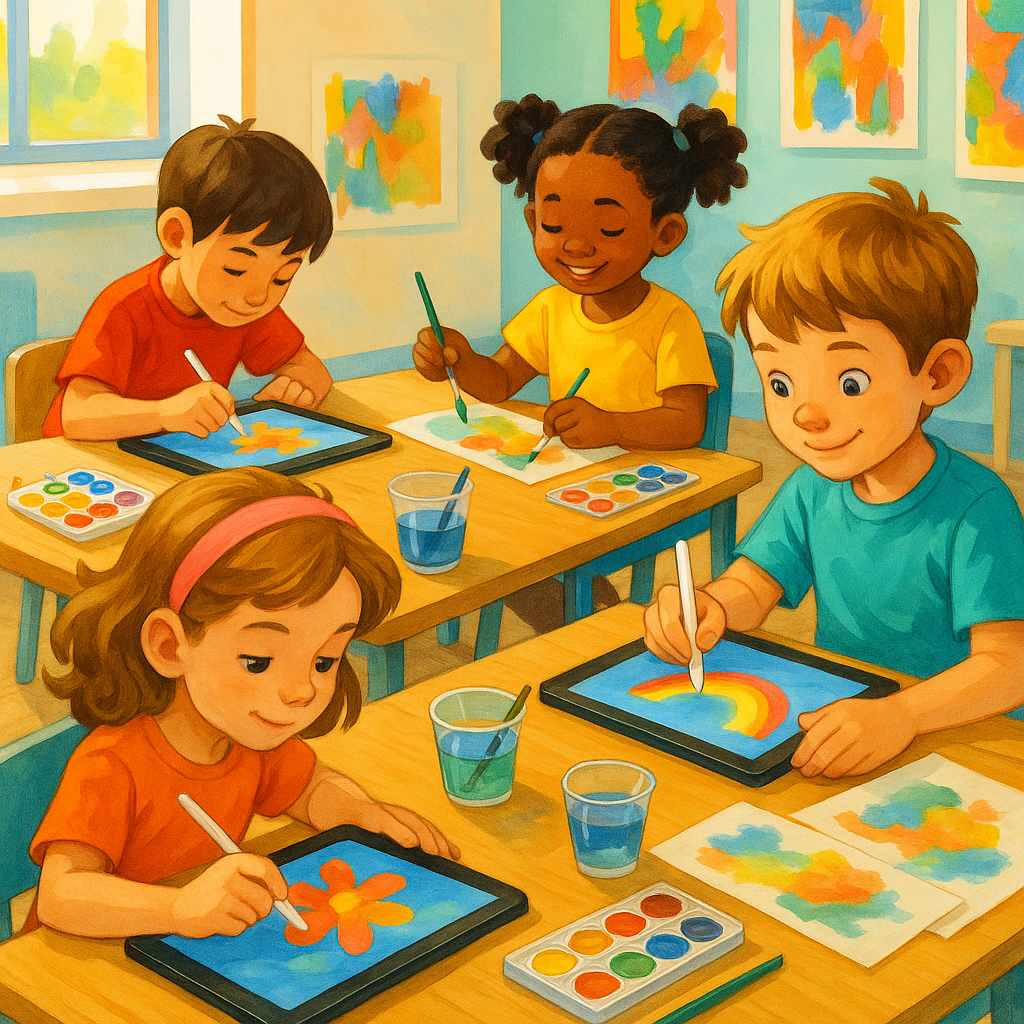Emerging trends in children’s art education in 2025 reflect a dynamic blend of tradition and innovation, emphasizing holistic development, technology integration, and sustainability. Here are the most prominent directions shaping the field:
1. Integration of Technology & Digital Art

- Classrooms now combine traditional art materials with digital tools, such as tablets, digital painting apps, and even 3D design and virtual reality software. These technologies make art more accessible, enable students to experiment with new media, and accommodate different learning styles. AI-powered platforms are also being used to create personalized learning paths, adapting instruction to individual abilities and progress. Digital portfolios allow easy sharing and assessment of student artwork.
2. Sustainability & Eco-Art

- There’s a strong focus on eco-friendly art practices, including creating artworks from recycled or natural materials and engaging children in environmental themes. This not only fosters creativity but also builds environmental awareness and responsibility. Projects such as “recycled art” encourage children to appreciate resources and understand the value of sustainability in creative expression.
3. STEAM & Interdisciplinary Approaches
- STEAM (Science, Technology, Engineering, Arts, Mathematics) education continues to grow. Art is incorporated into broader problem-solving and critical thinking activities, reinforcing its value within STEM fields, and making learning more engaging and interdisciplinary for children.
4. Play-Based, Experiential, and Emotional Learning
- Play, exploration, and sensory-rich experiences are at the heart of modern art education. Art is used not only to develop technical skills but also as a means for children to express emotions, build self-confidence, and strengthen social-emotional learning. Emotional intelligence (EQ) and resilience-building activities are now core components of art education programs. Children are encouraged to freely explore without fear of failure, growing both artistically and personally.
5. Global Awareness & Cultural Diversity
- Curricula increasingly highlight multicultural perspectives and global art traditions. Students are encouraged to participate in virtual international collaborations and explore artistic forms from various cultures, helping them develop empathy and global citizenship.
6. Gamification and Immersive Learning

- Art lessons are becoming more interactive and fun through gamification. Elements like challenges and rewards motivate participation. Virtual and augmented reality tools bring immersive, creative experiences into the classroom, from virtual museum tours to interactive art challenges.
7. Personalized and Adaptive Instruction

- AI and learning analytics are making it possible to adapt art lessons to each child’s unique interests, needs, and pace—maximizing creativity and confidence.
8. Focus on Creativity and Critical Thinking
- Creativity is now viewed as an essential “soft skill.” Art education prioritizes opportunities for original thinking, problem-solving, and innovation. Teachers encourage students to question, experiment, and connect their observations to broader issues, including social and environmental challenges.
These trends show that children’s art education is rapidly evolving, balancing foundational techniques with cutting-edge innovations to nurture engaged, creative, and thoughtful young artists ready to thrive in a changing world.
- https://learningmole.com/exploring-new-trends-in-arts-craft-education/
- https://e-journal.uum.edu.my/index.php/jdsd/article/view/25662
- https://www.digitallearninginstitute.com/blog/education-technology-trends-to-watch-in-2025
- https://www.jhs.ac.in/recycled-art-for-kids.php
- https://www.carnivalarts.org.uk/post/sustainable-arts-education
- https://www.create-learn.us/blog/popular-kids-education-trends/
- https://www.momatos.in/blogs/news/top-education-trends-for-kids-in-2025
- https://www.chrysaliskids.com/blog/top-preschool-education-trends-in-2025-preparing-your-child-for-the-future/
- https://pdi.ekyaschools.com/editors-choice/early-childhood-education-3/
- https://www.classcardapp.com/blog/11-edtech-trends-for-2025
- https://eepro.naaee.org/research/eeresearch/enhancing-preschoolers-creativity-through-art-based-environmental-education
- https://www.arteducators.org/resources/research/
- https://journals.bilpubgroup.com/index.php/jiae/article/download/9768/6201/44230
- https://www.unesco.org/en/weeks/arts-education
- https://www.educate-me.co/blog/future-of-education-technology
- https://study.com/academy/lesson/current-trends-in-art-education.html
- https://www.unesco.org/sdg4education2030/en/articles/colouring-future-youth-reimagining-education-sustainable-development-through-arts
- https://www.the74million.org/article/how-arts-education-engages-students-more-deeply-in-other-subjects/
- https://www.goldenroadarts.org/art-resources/top-ways-technology-enhance-art-education/
- https://www.unesco.org/en/articles/advancing-sustainability-education-through-art-expression-and-culture
